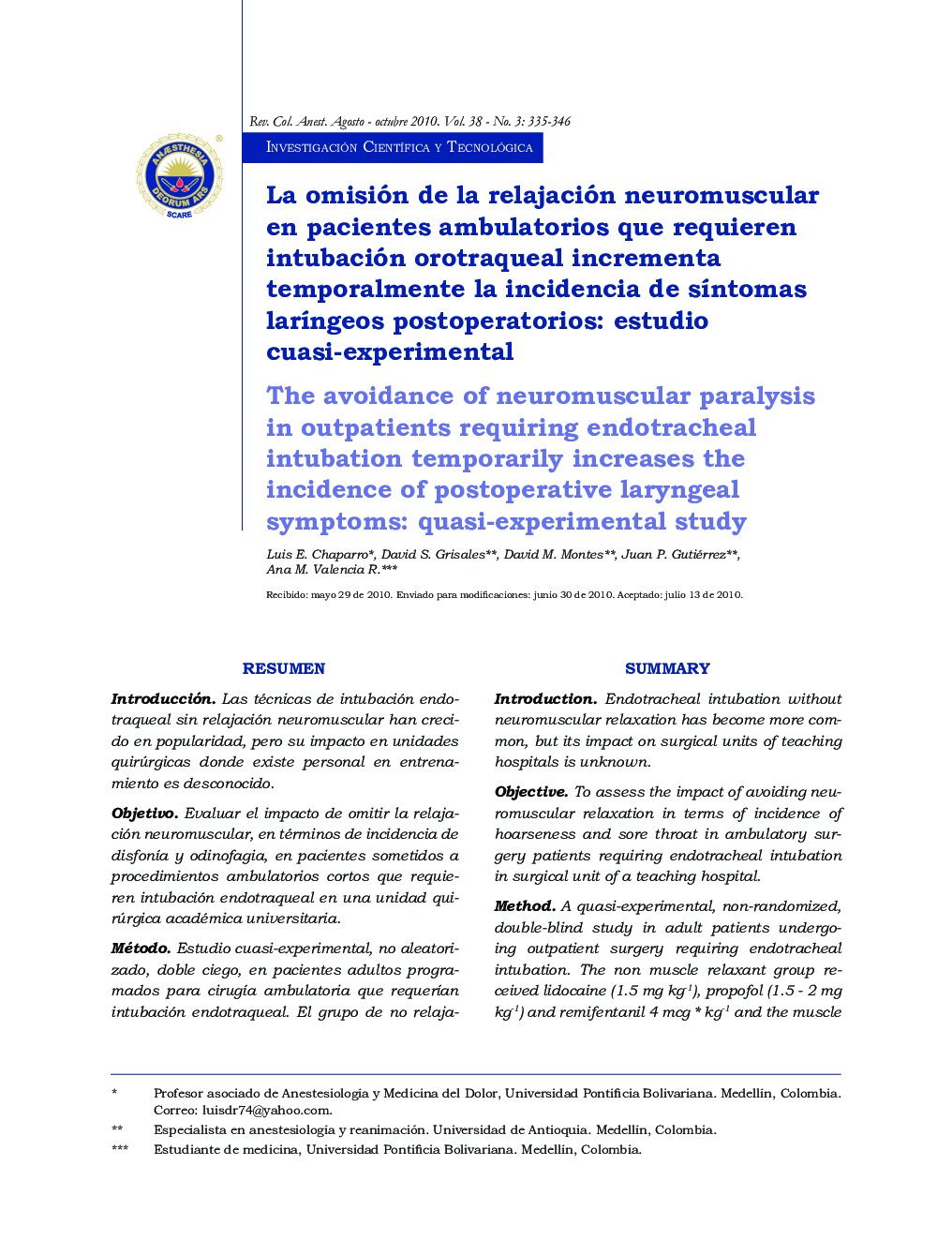| Article ID | Journal | Published Year | Pages | File Type |
|---|---|---|---|---|
| 2768123 | Revista Colombiana de Anestesiología | 2010 | 12 Pages |
RESUMENIntroducciónLas técnicas de intubación endotraqueal sin relajación neuromuscular han crecido en popularidad, pero su impacto en unidades quirúrgicas donde existe personal en entrenamiento es desconocido.ObjetivoEvaluar el impacto de omitir la relajación neuromuscular, en términos de incidencia de disfonía y odinofagia, en pacientes sometidos a procedimientos ambulatorios cortos que requieren intubación endotraqueal en una unidad quirúrgica académica universitaria.MétodoEstudio cuasi-experimental, no aleatorizado, doble ciego, en pacientes adultos programados para cirugía ambulatoria que requerían intubación endotraqueal. El grupo de no relajación recibió lidocaína (1,5 mg kg- 1), propofol (1,5-2 mg kg- 1) y remifentanil 4 mcg kg- 1, y el grupo de relajación recibió la misma técnica, y se adicionó rocuronio a dosis de 0,3-0,6 mg kg- 1. Los desenlaces primarios se evaluaron a los días 1, 3 y 14 postoperatorios.ResultadosSe incluyeron 287 pacientes. El 51,7 % recibió relajante neuromuscular. La incidencia de disfonía fue estadísticamente mayor a las 24 horas en el grupo de no relajante (26 % frente a 15 %; valor p: 0,016); así, no fue significativa a las 72 horas de seguimiento (0,6 % frente a 0 %; valor de p 0,37). No se encontraron diferencias en la incidencia de odinofagia entre los grupos. Los síntomas habían desaparecido en toda la población estudiada a la semana de seguimiento.ConclusionesOmitir la relajación neuromuscular se asocia con un incremento transitorio de disfonía a las 24 horas del posoperatorio, pero no de odinofagia. No existen diferencias en la incidencia de síntomas laríngeos en 72 horas. La adición de relajante neuromuscular para disminuir la incidencia de disfonía temprana puede estar justificada.
SUMMARYIntroductionEndotracheal intubation without neuromuscular relaxation has become more common, but its impact on surgical units of teaching hospitals is unknown.ObjectiveTo assess the impact of avoiding neuromuscular relaxation in terms of incidence of hoarseness and sore throat in ambulatory surgery patients requiring endotracheal intubation in surgical unit of a teaching hospital.MethodA quasi-experimental, non-randomized, double-blind study in adult patients undergoing outpatient surgery requiring endotracheal intubation. The non muscle relaxant group received lidocaine (1.5 mg kg- 1), propofol (1.5 - 2 mg kg- 1) and remifentanil 4 mcg * kg- 1 and the muscle relaxation group received the same technique and rocuronium 0.3 to 0.6 mg * kg- 1. The primary outcomes were assessed at days 1, 3 and 14.ResultsWe enrolled 287 patients, where 51.7 % received rocuronium. The incidence of hoarseness was significantly higher at 24 hours in the nonrelaxant group (26 % vs. 15 %, p value: 0.016) being not significant after 72 hours of follow up (0.6 % vs. 0 %;p: 0.37). We found no differences in the incidence of sore throat between the groups. All the study patients were asymptomatic at one week.ConclusionsAvoidance of neuromuscular relaxation is associated with a transient (First 24 hours) increase in hoarseness after ambulatory surgery, but no difference in sore throat. We found no differences in the incidence of laryngeal symptoms after 72 hours. The addition of muscle relaxant to reduce the incidence of hoarseness can be justified.
